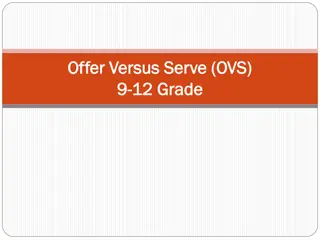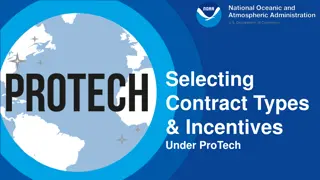Offer vs. Serve Training for School Food Authorities
Learn about Offer vs. Serve (OVS) meal service option for School Food Authorities, allowing children to decline some food items in reimbursable meals. Discover how OVS reduces food waste and costs with proper implementation. Training is essential for staff to assist children in selecting a reimbursa
1 views • 39 slides
Cost Of Production
Explore the concepts of production cost analysis, focusing on total fixed costs, total variable costs, total cost of production, average cost, and average fixed cost. Learn how these costs behave in the short run and their impact on a firm's operations.
0 views • 26 slides
University of Florida Cost Comparisons Directives
The University of Florida has established directives for cost comparisons related to business travel expenses. These guidelines ensure that the university is not paying for costs unrelated to official business. University travelers are required to obtain cost comparisons for upgrades, convenience, a
4 views • 23 slides
CITF Manpower Development Funding Support Overview
The Construction Innovation and Technology Fund (CITF) provides funding support for Manpower Development (MPD) to enhance productivity, automation, and digitization in the construction industry. With a total allocation of HK$2.2 billion, the CITF aims to boost technology adoption, improve site safet
0 views • 44 slides
Understanding Unit Cost Methodology Training for Area Agencies on Aging
This training provides an overview of cost allocation principles and the Unit Cost Methodology (UCM) through video sessions and practical applications using UCM spreadsheets. It covers federal regulations, the operation of UCM, and the importance of cost allocation in federally funded programs. The
2 views • 33 slides
Understanding Targeted Case Management (TCM) in Connecticut
Targeted Case Management (TCM) in Connecticut is a set of services aimed at assisting individuals with serious chronic mental illness, including substance use disorders. TCM providers play a crucial role in helping clients access medical, clinical, social, and educational services to enhance their q
1 views • 72 slides
Understanding Offer Versus Serve (OVS) in High School Meals
Offer Versus Serve (OVS) is a system required for high school meals, specifically for grades 9-12. It ensures that a reimbursable meal offers a variety of components, such as meat/meat alternate, grains, vegetables, fruits, and milk. Students have the option to decline certain components while meeti
0 views • 25 slides
Comprehensive Cost Management Training Objectives
This detailed training agenda outlines a comprehensive program focusing on cost management, including an overview of cost management importance, cost object definition, cost assignment, analysis, and reporting. It covers topics such as understanding cost models, cost allocations, various types of an
2 views • 41 slides
Cost-Benefit Analyses for Liquid Biopsy Studies: Understanding Health Economics and Decision Making
Health economics and decision making play a crucial role in evaluating the clinical utility and cost-effectiveness of liquid biopsies. Economic models such as cost-effectiveness analyses help in determining the incremental cost-effectiveness ratio (ICER) of interventions. Studies have shown varying
0 views • 23 slides
Understanding G-Invoicing Implementation at USDA
G-Invoicing is an online portal facilitating electronic information exchange for interagency agreements among Federal agencies. The system streamlines invoicing processes, standardizes transactions, and enhances communication for reimbursable activities. The implementation at USDA involves mandatory
0 views • 26 slides
Understanding Targeted Case Management (TCM) Services
Targeted Case Management (TCM) is a specialized service designed to assist individuals in accessing necessary medical, clinical, social, and educational services to enhance their quality of life. TCM services are reimbursable through Medicaid and are defined within the Medicaid State Plan Amendment
0 views • 73 slides
Academic Senate Resolutions and Low-Cost Thresholds in Higher Education
The Academic Senate addresses the adoption of open educational resources (OER) and low-cost materials to support academic freedom and compliance with legislative requirements. The resolution discusses the definition of low-cost resources and the variability among California Community Colleges in set
2 views • 9 slides
Understanding Cost Accounting Essentials
This overview delves into topics such as financial accounting, classification of accounts, cost ascertainment, and management accounting. It covers the meaning of cost, methods and techniques of costing, advantages and limitations of cost accounting systems, and essentials for a robust cost accounti
4 views • 27 slides
Project Cost Estimation: Methods and Factors
Project cost estimation involves valuing all monetary aspects necessary for planning, implementing, and monitoring a project. This includes various entrants such as preliminary investigation costs, design fees, construction expenses, and more. The purpose of cost estimation is to determine work volu
1 views • 44 slides
Understanding Risk, Cost of Capital, and Capital Budgeting in Corporate Finance
Explore the concepts of risk, cost of capital, and capital budgeting in corporate finance, including the Capital Asset Pricing Model (CAPM), cost of equity, beta estimation, and cost of capital. Learn how to reduce the cost of capital and understand the impact of reducing the Weighted Average Cost o
0 views • 20 slides
Understanding Targeted Case Management (TCM) Services
Targeted Case Management (TCM) is a vital service that assists individuals with serious mental illnesses and substance use disorders in gaining access to essential medical, social, and educational services. TCM is reimbursable through Medicaid and involves a systematic continuum of assessment, plann
1 views • 73 slides
Understanding Cost Accounting Fundamentals
Cost accounting involves determining the expenses incurred for producing goods or services, providing crucial information for decision-making, planning, and control. It aims to classify, record, allocate expenses accurately, presenting data for effective management guidance. Through cost classificat
0 views • 7 slides
Cost Control and Cost Reduction Strategies in Business: Understanding Implementation Challenges
Understanding the concepts of cost control and cost reduction is crucial for businesses, but implementing them can be challenging. This chapter explores the influencing factors for success in cost control and reduction, emphasizing the importance of cultural aspects, leadership, and management appro
1 views • 15 slides
Using Nutrition Facts Label in CACFP Webinar Series
This webinar series, "The CACFP Halftime: Thirty on Thursdays," provides interactive sessions on utilizing the Nutrition Facts label in the Child and Adult Care Food Program (CACFP). Operators learn how to identify items for reimbursable meals and snacks. To receive a participation certificate, comp
0 views • 4 slides
Understanding Activity-Based Costing (ABC) in Cost Management
Activity-Based Costing (ABC) is a strategic costing method that allocates overhead costs to products based on activities. It offers benefits such as accurate cost allocation and identifying cost drivers but also has challenges due to increased complexity and customization. ABC differs from tradition
1 views • 15 slides
Primary Care DES: Additional Roles Future Supply Workforce and Intelligence
The Primary Care DES introduces a scheme to recruit additional staff to address workforce shortages in general practice. Various reimbursable roles are available under the scheme, aiming to enhance capacity and support recruitment across different healthcare roles. Considerations are made regarding
0 views • 13 slides
Understanding Management Accounting and Cost Accounting
Management accounting involves planning, organizing, and controlling human efforts to achieve organizational goals, while cost accounting focuses on determining the cost of products and services. The objective of cost accounting includes cost analysis, reduction, and decision-making support.
0 views • 33 slides
Understanding Contract Types and Incentives Under ProTech
Explore the factors influencing contract types selection, including price competition, cost analysis, and technical capability. Learn about different contract types like fixed-price and cost-reimbursable, each with unique characteristics and risks. Discover the spectrum of contract types and incenti
0 views • 21 slides
Understanding the Cost of Capital in Finance
The cost of capital is crucial for businesses to determine the average cost of their finance. The Weighted Average Cost of Capital (WACC) is used as a discount rate in financial calculations. It involves estimating the cost of each source of finance and calculating a weighted average. Additionally,
0 views • 14 slides
Preschool Meal Pattern Guidelines
Learn about the importance of serving reimbursable meals in preschool programs, following federal requirements for reimbursement. Understand the components that make a meal reimbursable and the consequences if any components are missing. Explore the meal patterns for preschool breakfast and lunch, i
0 views • 21 slides
Understanding Multinational Cost of Capital
Multinational corporations determine their cost of capital based on the cost of debt and equity. The cost of debt includes the interest rate and credit risk premium, while the cost of equity reflects the risk premium investors demand. Estimating an MNC's cost of capital involves assessing these comp
0 views • 24 slides
Understanding Cost Accounting: Techniques and Processes
Cost accounting is a specialized branch of accounting that involves the accumulation, assignment, and control of costs. It encompasses techniques like ascertainment of costs, estimation of costs, and cost control to aid in decision-making. Cost accounting plays a crucial role in budgeting, standard
2 views • 11 slides
Factors Affecting the Amount of Depreciation in Asset Valuation
Depreciation in asset valuation depends on the cost, estimated useful life, and probable salvage value. The cost of an asset includes various expenses incurred to put it in working condition. Estimated net residual value is the expected sale value of the asset at the end of its useful life after ded
2 views • 5 slides
Alaska Child Nutrition Program: Meal Counting & Claiming Systems
Explore the Alaska Child Nutrition Program's guidelines on acceptable point of service counting and claiming systems, along with eligibility documentation, meal counts, and reimbursement procedures. Learn about acceptable meal counting systems and the importance of maintaining accurate records for f
1 views • 37 slides
Adult Day Care Meal Patterns Guidance for CACFP Participation
Providing well-balanced meals is crucial for adult day care centers participating in the CACFP. The meal pattern requirements ensure menus meet nutritional needs, align with Dietary Guidelines for Americans, and offer appetizing variety. Components for breakfast, lunch, supper, and snacks must be in
0 views • 26 slides
Child Meal Patterns Guidance for CACFP Participants
Child Meal Patterns Guidance for Institutions in CACFP aims to ensure well-balanced meals for children, meeting nutritional needs and aligning with Dietary Guidelines. The program specifies components required for breakfast, lunch/supper, and snacks to qualify for reimbursement. Menu planners must c
0 views • 26 slides
Introduction to Industrial Costing: Understanding Cost Types and Accounting Systems
Explore the fundamentals of industrial costing, including different cost types and accounting systems such as actual cost accounting, normal cost accounting, and standard cost accounting. Learn about cost data control, tasks of cost accounting, and the integration of cost type accounting in cost and
1 views • 24 slides
School Nutrition Certification Worksheets and Guidelines
School Food Authorities (SFAs) must accurately list and report reimbursable meals offered on the menu, including all required food components such as grains, meats, fruits, vegetables, and milk. This includes crediting fruit juice and vegetables properly based on volume served. The worksheets help e
0 views • 18 slides
Managing Summer Cost Share for Faculty with 9-Month Appointments
Explore the process of setting up and monitoring summer cost share for faculty with 9-month appointments. Learn why cost share for summer may not display on the FEC, how GCA establishes cost share using the Cost Share Module, and how departments should adjust the FEC to reflect summer cost share acc
0 views • 15 slides
Joint UNDP, UNFPA, UNICEF, UN Women Executive Boards Cost Recovery Briefing
Briefing on cost recovery for the joint Executive Boards of UNDP, UNFPA, UNICEF, and UN Women, covering topics such as feedback on cost recovery, role of core resources, cost recovery models using a LEGO approach, harmonization efforts, guidance for Executive Boards, and next steps towards proposing
0 views • 42 slides
Grant & Contract Accounting Updates - July 11, 2024
Vincent Gonzalez, Associate Director of Grant & Contract Accounting, provides updates on backlog reductions, cost reimbursable line status reports, new income processes, training grant tips, and webpage updates. The updates include progress in award setup, invoicing, reporting, and closing backlogs.
0 views • 11 slides
NYS Medicaid Incontinence Supply Management Program Overview
The NYS Medicaid Incontinence Supply Management Program, initiated in August 2016, aims to improve the quality of incontinence products provided to all Medicaid members by establishing minimum quality standards, reducing costs, and maintaining existing provider networks. The program covers a range o
0 views • 19 slides
Understanding Post Award Processes in Grant Management
Exploring the key differences between pre-award and post-award responsibilities in grant management, this content delves into topics such as Notice of Grant Award (NOA), Fixed Price Awards, and Cost Reimbursable Contracts. By elucidating these concepts, individuals involved in grant administration c
0 views • 83 slides
Defense Cost Reporting and Systems Overview
Defense Cost Analysis and Reporting Systems (CSDR) provide the cost community with essential data for developing independent cost estimates within major defense acquisition programs. The Defense Automated Cost Information Management System (DACIMS) offers instant access to historical cost informatio
0 views • 19 slides
Importance of Cost Accounting in Business Management
Cost accounting plays a crucial role in modern business environments where cost effectiveness and quality consciousness are vital for success. This branch of accounting helps in planning, controlling, and determining the costs of products or services, providing essential data for efficient managemen
0 views • 6 slides







































